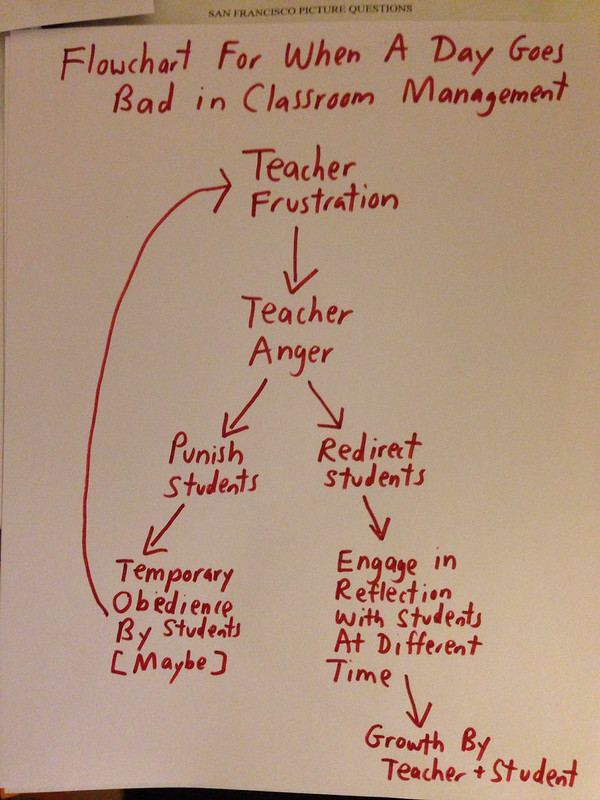As regular readers of this blog and my books know, I love teaching at our school.
Nevertheless, it is not a “walk in the park.” One hundred percent of our students receive a free breakfast and lunch, and many face other challenges inherent in the inner-city. Sometimes those challenges play-out in the classroom.
One of my classes has been a bit challenging classroom management-wise for me recently and it reached a crescendo last week. When one of those days happens, I will typically become frustrated and then angry, and every ounce of my being will want to punish. However, probably the key classroom management lesson I’ve learned over the years is that — more often than not — punishment will make things worse (of course, there are extreme cases when punishment is certainly necessary), so I am usually able to control that impulse.
Instead, I will jettison my lesson plan and redirect students into some less intensive learning activity that I know they will want to do (a game, get into their book discussion groups) and then make arrangements with teachers of the most egregious offenders to pull them out for several minutes the next day during my free period so I can have a one-on-one reflective conversation with them. For example, we’ll talk about what their goals are and how their behavior is hurting or helping to achieve them — if they want to be an Ultimate Fighter, not being able to show self-control is going to create problems. We’ll revisit some of the life skill lessons we’ve done and talk about what they think might help them develop more self-control (change seats, take their work outside if they feel they are “losing it,” get a stress ball, etc.).
Fortunately, these really bad classroom management days don’t happen very often but, when they do, my using this strategy has always worked, and I know it has worked better than what would have happened if I took the punishment route.
It fits into what I consider the best piece of classroom management advice I’ve ever read. It came from Marvin Marshall:
Will what I am about to do or say bring me closer or will it push me away farther from the person with whom I am communicating?
This really brings me to the main point of this post. In reflecting on all this over the past few days as I’ve seen — again — how effective this strategy can be, I thought I’d try putting it into a simple and rough flowchart.
Check it out here and let me know what you think and how it can be improved (I’m not sure if it will come through in an RSS Reader:




Larry,
These last few days before Christmas break, or any vacation, can be particularly challenging. This week my students have been especially chatty—and not in the good way, but in the off-topic, “excited for vacation, and done-with-school” kind of way. Typically, I also, do a “redirect” to something I know students will participate appropriately in—but right before vacay, I am on the curriuculum train, with time running out! I never thought about it before, but I do think teacher stress before vacay influences student behavior.
This was my solution. I bought a few bags of jolly ranchers. When the kids started losing focus and talking off topic while working on an activity, I pretended to “lose my temper.” I said–well kind of yelled–“That’s it! I did not think I was going to have to resort to this…” the whole class froze in silence waiting for their punishment. I went slowly over to my desk, took the bag of jolly ranchers, gave them each one…and told them it is impossible to talk with a jolly rancher in your mouth. Oh, and don’t prove me wrong or you’ll never get another one 😉 While they were all happily sucking away—and I have never given candy before, it is high school after all….I had some words of wisdom to share about the importance of focusing, and how they needed to try harder. As students commented that they really thought I was mad there for awhile—I told them I was disappointed, and that I shouldn’t have to give HS students candy to behave appropriately.
This did the trick, believe it or not. Students were much more appropriate the rest of class and yesterday. Now, at this point in the year, I have built up trust in order for this shtick to work. And interestingly, I thought they would be asking for more candy the following day, but none of the classes did. I think your flow chart is spot on…but “redirection” can take different forms.
Would love to hear other strategies.
I love this post. So true! I will admit I’ve been down both paths, unfortunately. I’m human and make mistakes. However, I try to take the one on the right more often. It’s so much better for kids!
Appreciate you honesty most of all. You’re right on topic and very timely as the holi=daze mental fog is heavy with our students. Redirection is a skill I’m going to tune in on even more. I was already on this path, but wasn’t able to put it into words like you did, so thanks!
Also applicable for parenting!
I’d like to add that with both parenting and teaching I’ve found that it can be critical to reflect on the problem immediately following the redirect, as Mary’s comment shows.
What a great post! It reminds me that my job is not to manage students, but rather, my job is to manage how I interact with students. Through your reflective conversations with students you are creating teaching moments, and by having the conversation the following day, much of the anger has diffused. As you’ve shown, even the best teachers have ups and downs with classroom management, but the choice of how to respond to students is in the teacher’s hands.